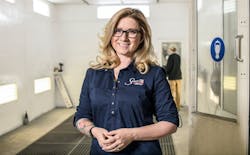You always dream of that first job being something fulfilling, something great, Juliet Lightner says. After years of attending auto shows with her father and brothers, her first internship as an auto body technician was promising and exciting.
But, then again, things don’t always work out the way we plan them, she adds.
“The internship did not go well,” she says. “They said I was too distracting and that I should get an office job somewhere. And I didn’t like that answer.”
Lightner, who says being a young woman in collision repair resulted in similar remarks from others in the industry as well, used the discouragement as fuel for her career. She started with attending WyoTech, where she specialized in chassis fabrication and high-performance engines, and then working her way through the industry, from estimator to insurance representative to certified I-CAR instructor, all before landing a management position at Major’s Select Collision Center, one of four Pennsylvania body shops in the Select Collision Group—all by the age of 27.
Select Collision Group owner Lee Cadwallader says it’s Lightner’s communication skills and dedication to continuous improvement that make her a fantastic leader, and it’s evidenced by how the young manager structures her day-to-day.
When I first get in, I take a couple minutes to glance through my emails. I normally don’t have time to look at them throughout the day, so I will start and end my day with emails.
Then I go through our production board and update that if needed, in case any technicians stayed late the night before. I print out a production schedule that I give to each employee at our morning meetings at 9 a.m.
The morning meeting is usually pretty straightforward. We have everybody in the shop, from the front desk to the parts department to estimators, included in that. It’s normally a good time for techs to let us know if there are any parts holding them up for the repairs. We go over what’s in process, if any cars are coming in, and if any cars are being delivered that day. We also address any customer updates that are needed at that time as well.
They only last 10 minutes or so, but it’s a good way to set the tone of the day. I try to lighten the mood a little bit, get them laughing and in a good mood. Everybody gets on the same page and feels a little more confident about the schedule.
After the meeting, we make notes during the process of any insurance adjusters that need to be followed up with, any customer updates needed, which typically our office manager or estimator will handle. We try to give all our customers at least one or two general repair updates throughout the week.
At those morning meetings, I’ll make time for passing along any important technical information that will help everyone become better at their jobs. Right now, what we’re really trying push is not focusing on specific training, but instead focusing on teaching our employees what information is available and how to attain it.
For instance, on the repairability technical support portal of I-CAR’s website, it has all the information for vehicles regarding post-repair calibrations. All our technicians are outfitted with that, and it’s right at their toolboxes. So whenever you search for a vehicle, it’ll show what all the optional sensors and convenience items, like lane change systems and parking assistance, that vehicles have and whether they need to be recalibrated after a loss. We’ve been trying really hard to push our technicians and estimators to be aware of those items.
Sometimes we’ll host little training seminars. If it’s too big for a morning meeting, I’ll host a lunch-and-learn event, where we’ll buy lunch for everyone and go over a new piece of technical information.
For the rest of the morning, I use any free time to focus on shop development planning. I’m the training coordinator for all of our facilities, so I’ll go through and see if there’s any training upcoming that needs to be scheduled and follow up on certifications we’re working on. For instance, we just became Honda ProFirst certified.
Throughout the day, I’m balancing writing estimates and walking the shop floor. I write estimates for our two biggest DRPs and the Bobby Rahal Automotive Group.
Bobby Rahal is a large local dealership. They refer their customers to us, and we also handle internal work for them. As a whole, we share a lot of the same principles and ideals on how we run our businesses and how we handle customers. So we really enjoy working with them, because it’s another group of people who set the bar and expectations of how they want their shops to run and employees to treat customers.
With scheduling, I always try to leave at least a chunk of hours per week for any of their customers that have imminent issues. So we do keep that in mind whenever we’re scheduling our drivable vehicles.
I try to follow up on the cars that will be coming to us, as well as the cars that left us. A lot of times, I will call back and thank the service advisor if they did refer someone to us. I try to keep that relationship happy and keep the communication as open as possible. When we’re obtaining certifications, I’ll call and discuss any programs we’ve come across that are beneficial to dealerships and pitch it. Any helpful information that we can give them helps us in the long run as well.
In the afternoons, I spend most of my time out in the shop, looking at everything with our technicians, getting them whatever they need. I got a Fitbit just so I can track how many steps I take. I normally do about 15,000 steps per day. I’m pretty much constantly moving throughout the shop, being there for anything needed and being a helpful resource for my employees.
I try at least once every two hours to go through the shop. I have a tablet I use our management software on, and I’ll speak with techs and make updates as I’m walking around the cars. We have several layers of quality control built into our process. So whenever a car comes to us, we check it in, document any unrelated prior damage, and document the full condition of the vehicle. Then before my body tech applies primer on any repairs, they get me so I can take a picture of the repair in process.
Then I will check it before it’s painted, glance over the estimate, make sure the body work looks good, and then I also check it after it’s painted, before it’s reassembled. That way if there’s any kind of issue with the paint whatsoever, we can try to handle it before it’s actually built and ready to go. And then we do a final quality control check at the end where we look at the final product.
To close out the day, I’ll try to do my final audit on any vehicles that have gone, lock them, upload them to the insurance companies and send them the final payment. I do all the file uploads needed, and then I’ll check my emails one last time to see if there’s anything I need to take care of first thing for the following day.




